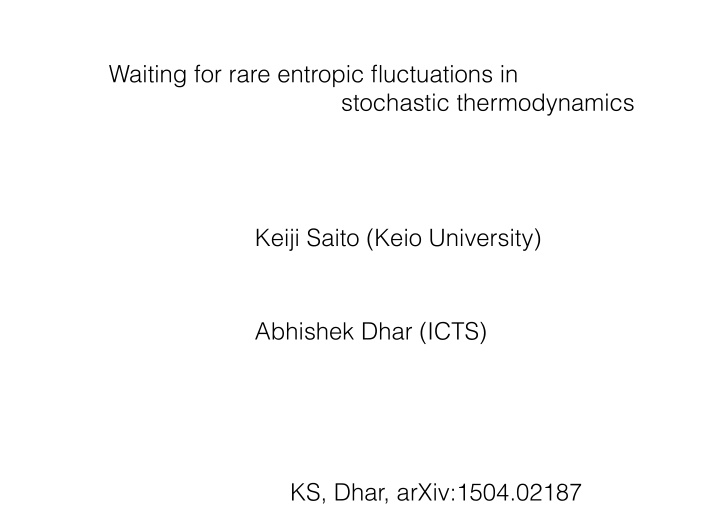



Waiting for rare entropic fluctuations in stochastic thermodynamics Keiji Saito (Keio University) Abhishek Dhar (ICTS) KS, Dhar, arXiv:1504.02187
Content 1. Counting statistics 2. From fixed time to fixed Q statistics 3. Basic equation 4. Mean residence time and integral FT 5. Summary and outlook
1. Counting statistics ♢ Measuring charge transfer X time measure accumurate ♢ Statistics given at the “fixed” time Probability Cumulants ♢ One expects “information” from “fixed time statistics”
Examples of experiment T. Fujisawa et al., Science (2006) ♢ Classical transport via coupled QDs +q (1,0) → (0,1) forward tunneling (0,1) → (1,0) backward tunneling ♢ Distribution of transmitted charge
Information from “fixed time statistics” ♢ Zero temperature - Shot Noise - Average current Current noise Fano factor “Noise is the signal” ♢ Finite temperature ? Fluctuation relation
Fluctuation relation at the finite temperature ♢ Robust relation derived from time reversal symmetry - Current context - Entropy context (general) ♢ This reproduces linear response results and predicts nonlinear response Def. - FDT (Kubo formula) , e.g., - Nonlinear response
Today’s talk 2. From fixed time to fixed Q statistics ♢ So far, statistics at the fixed time - Questions - What is fixed Q statistics ? How formulated ? Relation between fixed time and fixed Q physics ? How interesting ? X time target Q fixed Q statistics fixed time statistics ♢ Mathematically unambiguous statistics First passage time distribution (FPTD) to get Q
The simplest FPTD: random walk ♢ Biased random walk ‥‥ O ♢ Distribution at large time ��� τ � n � � I n = dt x ( t ) c / τ � � τ →∞ 0 ♢ First passage time distribution (FPTD) to reach X
Several models for the FPTD (a) Driven colloidal particle Equation of motion Entropy produced = ] [ Experiments S. Toyabe et al., Nature Physics(2010) Target: winding number V. Blickle et al., PRL (2007) (b) Charge transfer vi QDs Entropy produced = Experiments Target: charge transfer T. Fujisawa et al., Science (2006) B. Kung et al. ,Phys. Rev. X (2012) (c) Heat transfer Entropy produced = J. R. Gomez-Solano, Europhys Lett.(2010) Target: heat transfer S. Ciliberto et al., PRL (2013)
[ ] 3. Renewal type equation for first passages ♢ Framework to reach entropic variable system states : Initial state : “Entrance state” to reach for the first time ♢ Renewal type of basic relation transition prob. FPTD for via ♢ Laplace transformation
Example with driven colloidal system ♢ Take winding number as unique entrance state ♢ Take bath’s entropy as (negative) two entrance states
The FPTD in the driven colloidal particle (model a) Entropic variable: winding number ♢ Formal solution
♢ ? ・ Master equation local detailed balance ・ Counting the number of passing through the line: n 2 1 ・ Define the probability vector ・ Solution in Laplace space fluctuation relation
Two results 1. Asymptotics [ ] → General expression in terms of cumulants 2. Mean residence time and integral FT in model (a)
1. Asymptotics More precisely the cumulant generating function 1. Asymptotic behavior does not depend on the target values (even negative entropy follows the same form) 2. Relaxation rate is written with cumulants 3. First order reproduces random walk picture valid for linear response 4. (3/2)log t correction
Numerical demonstration ♢ Normalized FPTD for winding number Random walk fitting (fails to fit) Theory Unnormalised FPTD
Numerical demonstration (b) FPTD for charge transfer Theory (c) FPTD for heat transfer random walk fitting Theory
2. Mean residence time expression and integral FT Statement: Model (a): colloidal particle in the ring geometry ♢ Exact expression of mean residence time ♢ Integral FT in terms of first passage All first passage trajectories to get S (S<0) ・ Usual definition Total entropy = system’s entropy + bath’s entropy
Formula on mean residence time ♢ Mean residence time steady sate distribution steady sate current return probability Remark on this formula 1) In equlibrium case, it diverges, as we know. 2) The formula includes equilibrium result. 3) Residence time is connected to the steady state as well as steady state current.
Integral FT in terms of first passages ♢ Mean residence formula + basic equation leads to integral FT in terms of first passages All first passage trajectories to get S (S<0)
Numerical demonstration 0 . 01 1 � ∞ dt T x,x (0 , t ) 0 ⟨⟨ e − S tot ⟩⟩ S P SS x /J 0 0 . 005 − 3 − 2 − 1 0 S 0 0 0 . 25 0 . 5 0 . 75 1 x
Summary ♢ We considered fixed target value statistics ♢ The first passage time distribution was studied (FPTD) ♢ Basic equation on first passages are considered ♢ Asymptotic behaviour has universal expression ♢ Exact mean residence time expression was derived ♢ Integral FT in terms of first passage exists for the model (a). Validity for the other models is open problem Thank you for attention !
Recommend
More recommend